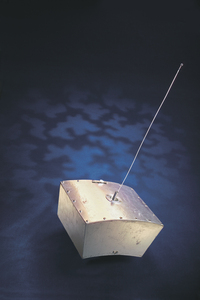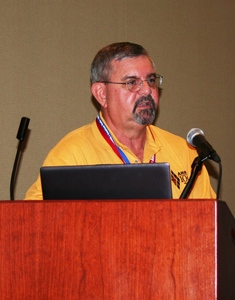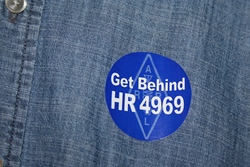Analyst's note: Ham radio continues to save lives as it begins its second century.
"Radio is one of the most resilient communications technologies we have," Fugate said. "When the power is out and telecommunications are down, the Amateur Radio community can serve as a vital resource in support of emergency responders and survivors during a disaster. This MOA will strengthen FEMA's partnership with ARRL and build upon our work to expand emergency communications capabilities and the use of Amateur Radio in emergency management."
******
FEMA and ARRL Sign Agreement; FEMA Administrator Calls Ham Radio "Resilient"
The ARRL and the Federal Emergency Management Agency (FEMA) have announced a Memorandum of Agreement (MOA) that will enhance cooperation between the League and FEMA in the area of disaster communication. FEMA Administrator Craig Fugate, KK4INZ, and ARRL President Kay Craigie, N3KN, signed the agreement July 18 during the ARRL National Centennial Convention in Hartford, Connecticut.

FEMA Administrator Craig Fugate, KK4INZ (left) and ARRL President Kay Craigie, N3KN, sign a Memorandum of Agreement. [Rick Lindquist, WW1ME, photo] |
"Radio is one of the most resilient communications technologies we have," Fugate said. "When the power is out and telecommunications are down, the Amateur Radio community can serve as a vital resource in support of emergency responders and survivors during a disaster. This MOA will strengthen FEMA's partnership with ARRL and build upon our work to expand emergency communications capabilities and the use of Amateur Radio in emergency management."
The new agreement will allow FEMA and ARRL to work together to provide resources, services and personnel, as available, in order to strengthen capacity in areas of emergency communications, mass care and emergency assistance, disaster preparedness, response and recovery, while also raising public awareness about the use of Amateur Radio as a public safety resource. The pact also outlines the ways in which FEMA and ARRL will cooperate to carry out their respective responsibilities, with respect to disaster mitigation, preparedness, response and recovery operations in the event of a natural or manmade disaster.

(L-R) National Hurricane Center Amateur Radio Coordinator John McHugh, K4AG; FEMA Administrator Craig Fugate, KK4INZ, and NHC Assistant Amateur Radio Coordinator Julio Ripoll, WD4R. [Rick Lindquist, WW1ME, photo] |
Craigie said that from radio's earliest days of experimentation to the present, ham radio volunteers have combined a passion for technology with a devotion to assisting agencies that respond to disasters. "This combination of inventiveness and service has saved lives for a century," she said. "We look forward to working with FEMA to further develop opportunities for trained, equipped and prepared Amateur Radio operators to serve the public interest whenever and wherever disasters affect our country and its communities."
Fugate echoed his afternoon remarks as the keynote speaker at the ARRL National Centennial Convention Banquet Friday evening. He said that before he even became FEMA administrator, it became clear to him that Amateur Radio could support ad hoc communication without relying on conventional communication systems. "The more sophisticated our systems become, the more fragile they become," he told the gathering of some 900 dinner guests. He again emphasized the need for resiliency in communication systems, and asked, "How many public safety networks can come close to ham radio's bandwidth?"
"The relevancy of ham radio only grows," he asserted. "Amateur Radio is taking that hobby and turning it into saving lives."
******
Ham Radio Aids in Rescue of Injured Colorado Hiker
While Bill Eberle, AB0MY, of Boulder, Colorado, and his wife Mary were hiking in the back country on July 21, they encountered a team of paramedics rendering aid to a 67-year-old man -- Michael Schuett, of Bloomfield, Colorado -- who had lost his footing while crossing a stream. Schuett had struck his head on a boulder and was found unconscious and face down in the water by another hiker, who had pulled him to safety. The paramedics, en route to a youth camp, also had stumbled onto the scene.
Lacking cell telephone coverage, Eberle put out a distress call on the hand-held transceiver he always takes along when he hikes. Promptly answering his call on the statewide Colorado Connection Repeater system was Ryan Frederick, KD0TSZ, in Colorado Springs. Frederick contacted the Boulder County Sheriff's office. Authorities quickly turned to Scott Whitehead, KA0QPT, of Longmont, a sheriff's department radio specialist and 30-year veteran of the Rocky Mountain Rescue Team. Whitehead was able to contact Eberle via the repeater network, and the two coordinated equipment and rescue personnel.
Schuett was evacuated from the scene, treated at an area hospital, and released. He credited ham radio for bringing the rescuers to him. -- Thanks to John Bigley, N7UR, Nevada Amateur Radio Newswire
******
During the decade of the 1960s and subsequently, Gus Browning, W4BPD, traveled the world and operated from over 100 countries, many of them extremely rare ones and sometimes the first ham operation for that country. Gus was an ordinary guy, always a gentleman, and an unflappable pileup operator. He was the first DXer elected to the DX Hall of Fame.

An ARRL prototype of OSCAR 1. |
On December 12, 1961, OSCAR 1, the first Amateur Radio satellite, was launched into orbit. OSCAR 2 followed on June 2, 1962. Both paved the way for the amateur satellites that followed.
By 1963, the US ham population had reached a quarter of a million, although at that time there were more CB operators than hams.
During the 1960s, repeater operation began on 2 meters. At first, there was a fair amount of confusion -- questions of legality had to be sorted out by the FCC, a lot of hams thought channelized operation wasn't a good thing, equipment had to be developed, etc. But eventually things settled down, and repeater operation on 2 meters took off, with repeater operation on other VHF/UHF ham bands and 6 meters soon to follow.
On March 27, 1964, a magnitude 9.2 earthquake and the resulting tsunami struck Alaska and caused extensive damages in many parts of the state. As in most natural and man-made disasters, hams were quick to put together emergency communication links to help with disaster relief.
Late in 1967, incentive licensing returned to ham radio. This had been an on-again/off-again issue with FCC for about 15 years. -- Al Brogdon, W1AB
******
Centennial Convention Provides Springboard for "Amateur Radio Parity Act," HR.4969
The just-concluded ARRL National Centennial Convention in Hartford, Connecticut, helped to infuse some energy into efforts to line up co-sponsors for "The Amateur Radio Parity Act of 2014" -- HR.4969.

ARRL Chief Counsel Chris Imlay, W3KD. [Rick Lindquist, WW1ME, photo] |
The measure, introduced in the US House of Representatives with bipartisan support in late June, calls on the FCC to apply the "reasonable accommodation" three-part test of the PRB-1 federal pre-emption policy to private land-use restrictions regarding antennas. The bill's primary sponsor is Rep Adam Kinzinger (R-IL). It received initial co-sponsorship from Rep Joe Courtney (D-CT). An additional four co-sponsors have since signed aboard the bill. Courtney visited the ARRL Centennial Convention on July 19 to speak with League officials and those attending the event. At present PRB-1 only applies to state and municipal land-use ordinances, and the FCC has indicated that it will not act to provide the same legal protections from private land-use agreements -- often called covenants, conditions, and restrictions (or CC&Rs) -- without direction from Congress.
Convention visitors began sporting League-supplied "Get Behind HR 4969" stickers as the event shifted into high gear. Behind the stickers is a grassroots effort to encourage members to contact their congressional representatives to seek their support as co-sponsors for HR.4969. The effort at the Convention to entice visitors to sign letters to lawmakers yielded some 1400 constituent letters that will be hand delivered to members of Congress, a July 19 Convention Legislative Update Forum was told.
ARRL Ge neral Counsel Chris Imlay, W3KD, said there already is precedent for the FCC to act. He explained that the Commission's so-called Over-the-Air Receiving Device (OTARD) rules currently preempt private land-use agreements to permit the installation of television antennas and satellite dishes. He suggested that making the leap to reasonably accommodating outdoor Amateur Radio antennas is within the FCC's regulatory scope, given the established strong federal interest in effective Amateur Radio communication.
neral Counsel Chris Imlay, W3KD, said there already is precedent for the FCC to act. He explained that the Commission's so-called Over-the-Air Receiving Device (OTARD) rules currently preempt private land-use agreements to permit the installation of television antennas and satellite dishes. He suggested that making the leap to reasonably accommodating outdoor Amateur Radio antennas is within the FCC's regulatory scope, given the established strong federal interest in effective Amateur Radio communication.
"People don't always get to choose where they live," Imlay said. CC&Rs enforced by homeowner's associations may or may not permit

Initial HR.4969 co-sponsor US Rep Joe Courtney (D-CT) visited the ARRL Centennial Convention. [LJB Special Photography photo] |
antennas or may only permit them with approval. He said that by 1990, some 29 million US residents were affected by private land-use agreements. "In 2011, that number changed to 62.3 million people," Imlay said. The goal, he explained, is to compel homeowner's associations to negotiate "reasonable accommodation" with an affected radio amateur. That could mean an outdoor wire antenna or something more elaborate; Imlay said it's not the intent of the bill to specify any particular type of antenna.
HR.4969 has been referred to the House Energy and Commerce Committee. Rep Greg Walden, W7EQI (R-OR), chairs that panel's Communications and Technology Subcommittee, which will consider the measure. The League had approached Walden, who helped to engineer the current legislation.
"All [the bill] says is, take PRB-1, and apply it to all land-use regulation," Imlay said. "This couldn't be any simpler."
Imlay said the bill faces opposition from the Community Associations Institute and an organization called Associa, which has suggested to Kinzinger that he "re-think" the bill.
"We need to get a lot of co-sponsors for this bill," Imlay said.

ARRL Hudson Division Director Mike Lisenco, N2YBB. [Rick Lindquist, WW1ME, photo] |
A principal proponent of HR.4969 is ARRL Hudson Division Director Mike Lisenco, N2YBB. "We are the ones who are responsible for our own future. The way to get things done is to be active on a grassroots level -- small scale," he told the gathering of about 50 interested radio amateurs. "This way you're dealing with your representatives as a constituent." Several forum attendees left early so they could visit the ARRL exhibit on the convention floor to obtain the necessary materials.
ARRL Regulatory Affairs Manager Dan Henderson, N1ND, pointed out that the League has opened a HR.4969 page on the ARRL website. It contains information and resources for clubs and individuals wishing to support efforts to gain co-sponsors for the measure by contacting their members of Congress. It includes a sample letter to a member of Congress and a list of "talking points." Lisenco recommended organizing small teams of knowledgeable and articulate radio amateurs to approach lawmakers one to one to plead their case.
Just prior to the Convention, ARRL President Kay Craigie, N3KN, released a video appeal to all radio amateurs to get behind a grassroots campaign to promote co-sponsorship of HR.4969.









